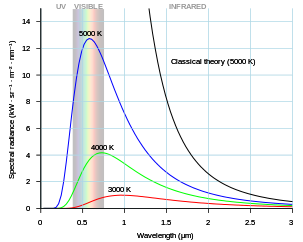I already know the fact that when solid objects heat up, they emit thermal energy which is also known as infrared radiation. However, if the atoms in that solid were to begin gaining more or less kinetic energy, could the excited electrons then begin emitting radio wave or gamma wave radiation in the far regions of the electromagnetic spectrum?
2 Answers
There are four fundamental states of matter in aggregate , solid, liquid, gas and plasma. As the temperature goes up, i.e. the average kinetic energy of the atoms/molecules increases, matter transits to the next in order state with a phase transition. The black body radiation depends on temperature and temperature is proportional to the average kinetic energy of gas molecules, for example .

As the temperature decreases, the peak of the black-body radiation curve moves to lower intensities and longer wavelengths. The black-body radiation graph is also compared with the classical model of Rayleigh and Jeans.
The whole spectrum is covered , the change in temperature changes the percentages of the type of radiation in the total.
Note that higher energy radiation is towards the left. The sun, which is a ball of plasma has a large percentage of its radiation in the optical wavelengths. The light comes from the excitations and deexcitations of the electrons and nuclei that compose the ionized plasma. In addition ionized molecules and atoms radiate in the continuum, due to the magnetic fields generated in the plasma .
Plasma temperatures that emit gammas are expected in fusion reactors as ITER.
X-rays and gamma rays have been observed in astronomy , and various models are developed to explain the phenomena, which are at the highest temperatures attainable in the collapse of a star to a supernova, for example.
Yes, depending on the temperature the emission can be anywhere in the electromagnetic spectrum. Check out this graphic from NASA and the Harvard-Smithsonian Center for Astrophysics:

As you suggest, when an object cools or heats the kinetic energy of the atoms decreases or increases (respectively), and the peak of the radiation shifts. Note that what is listed on the graphic above is just the peak wavelength. For example: stars like Eta Carinae have temperatures well above 10,000 K and thus have peak emission in the ultra-violet range. Yet Era Carinae also radiates a lot of visible light and in fact is possibly visible to the naked eye as it has a magnitude of 6.2.
